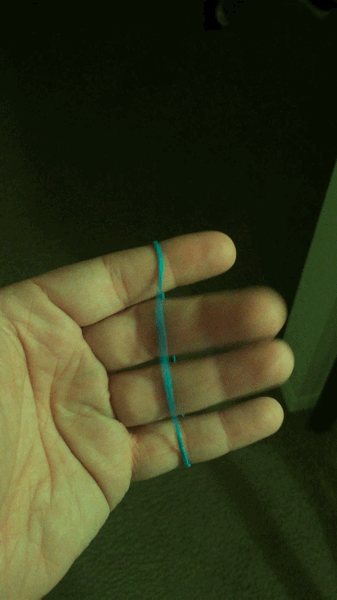I've just linked to an example, but there are all sorts of different types of puzzle boxes to be found out there. You can find some that take dozens of steps to open.
What to do with them?
Well, I just think they add a general air of mystery to the proceedings. If you want to pull out some strange artifact, it becomes even stranger if it's stored in this box. Or if you keep a prediction in there, it makes the prediction somewhat more intriguing than if it's just in an envelope or something. You could have the steps to open the box written on different cards, have them mixed and laid out in a row by the spectator and it turns they've somehow placed out the cards in the order required to open the box.
Or just stick your weed in it, you fucking burnout.
Optical Illusion Cards
For a long time I thought of optical illusions as things that 10-year-old boys liked and no one else really cared about. But in recent months I've been working on a number of pieces where I transition from an optical illusion into a magic trick and I've found it remarkably easy to not only make that transition in a seamless way, but to capture people's interest in the first place with an optical illusion. The key is to look for illusions that retain some element of surprise in them. The ones where it's like, "Which line is longer? Actually they're the same size," are so well known that nobody really cares.
Having a deck of cards like this has been useful for me both in generating ideas for effects and also as a Hook that can be left out on an end-table to capture the unsuspecting little minnows who pick it up.
App Store and iTunes Gift Cards
Gift cards are a bit of a cheat. I mean, as a gift it's pretty lazy. And maybe it's even a bit of a cheat for me to include them on this list. But there's no denying that they fall into the category of being a not overtly magical gift that you can easily use in your practice of magic.
The obvious manner to do this is, of course, with magic apps. I recommend Marc Kerstein's apps, just because those are the ones I'm most familiar with and actually use. I know there are other great apps out there but I just haven't played around with them enough to recommend them.
Another app I'd recommend that isn't a magic app, but I use it all the time to help in keeping my magic repertoire orgainzed, is called Tap Forms. It's a personal database that lets you track pretty much anything. I have two main databases that I keep in this.
The first is for people I meet. My lifestyle has me coming into contact with new people almost daily. You may think it's creepy or nerdy to create a database of people like this, but whatever, it's pretty much a necessity for me. It's nothing weird. It's not like, "Karen: The redhead. Her boobies are a 10. But her face is just a 5." I'm not an asshole. I'm just keeping track of people's names, where we met, when we met, their birthday, their job, if they're married and/or have kids (and the names of those family members). This is all stuff I find out from them directly, I don't do research behind their back. And it's all the sort of thing that I think most people would hope people would remember about them.
I also keep track of the tricks I've performed for them.
And that is the second major database I keep in this app, the tricks in my repertoire. I keep track of: the name of the effect, where it can be found, who created it, what the requirements are, how long it takes to perform, when I've performed it, the reactions it got, and so on.
So now I can search for any combination of things in regards to the tricks in my repertoire. I can look for what tricks are impromptu and coin tricks, for example. I can look for the ones I haven't performed in over two years. I can look for the ones that consistently don't seem to get the reaction I would expect and either modify them or ditch them altogether. Or I can look up a particular person and see exactly what tricks I've performed for them and which type of trick seemed to generate the strongest reaction from them.
Tracking people and tricks like this may seem excessive, I get that. But if you're performing a lot and meeting a lot of new people it won't feel that way. And this database app has been the easiest way I've found to keep track of it all.
The Lollipopter
This is a piece of "playable art" that goes from a helix form to a burst form with a twist.



















